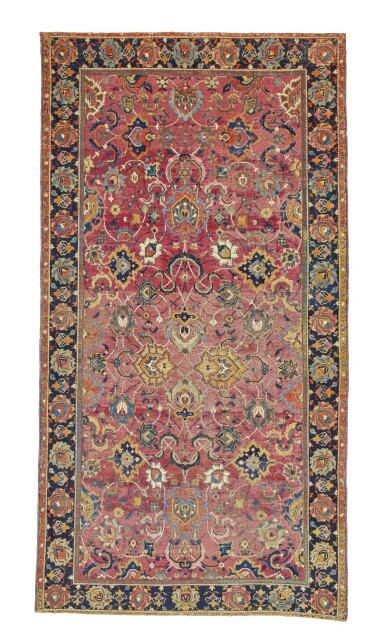
Property from a Prominent Private Collection
A Safavid 'spiral vine' carpet, Central Persia, probably Isphahan, 17th Century, probably first half
Auction Closed
March 31, 12:40 PM GMT
Estimate
12,000 - 15,000 GBP
Lot Details
Description
approximately 299 by 157cm.
This carpet with its complex, layered design of spiraling tendrils terminating in palmettes belongs to the red ground, so-called "spiral-vine" or “in and out palmette,” group of carpets from the Safavid dynasty (1502-1732), believed to have been woven in Isphahan. This particular design appeared first in the sixteenth century and continued to find favour throughout the seventeenth century. The earliest examples of the spiral-vine carpets are characterized by the use of silk in the foundation, an unusually wide variety of colors and superbly delineated drawing. The present lot, with cotton foundation, probably dates from the first half of the 17th century: the scrolling interplay of white and dark blue vines support elaborate polychrome palmettes at various scales and in a broad range of colours, and includes sinuous and elegantly drawn cloudbands.
By the end of the seventeenth century the “in and out palmette” pattern had fallen almost completely out of favour in the export markets of England and of continental Europe, as European manufacturers such as Aubusson, Savonnerie and Axminster began to provide carpets for their domestic markets. Surviving documentation from the East India Company, which was the main exporter of these carpets to the West, indicates their decline of popularity. A letter from the company’s governors from 1686 state: “You must never send us any more Persian carpets, for those that we had by way of Surat will not yield us here above a third of what they cost in Persia, which gives us just that cause to fear that we were abused in the price of them, the greater cause of our loss being that such rich carpets are now grown much out of use in Europe,” see J. Irwin, “Indian Textile Trade in the Seventeenth Century,” Journal of Indian Textile Trade, I, 1955, pp. 5-33. In the second half of the nineteenth century, and early 20th century there was a resurgence of Western interest in the use of ‘classical’ oriental carpets for decoration, particularly for the homes of those made rich by the industrial revolution. The red ground, spiral vine and palmette carpets such as this lot were once again in great demand, and carpets such as this were as prestigious and coveted as Old Master paintings by collectors such as the Rothschilds, J.P Morgan, the Fricks and William A. Clark. Their desirability is evidenced in The Important Carpets from William A. Clark Collection, Corcoran Gallery of Art, sold Sotheby’s New York, June 5, 2013, which included a range of ‘spiral vine’ carpets (see lots 3-6 and 10-23 https://www.sothebys.com/en/auctions/2013/so-rugs-n09012.html ). As their ongoing success at auction shows, they continue to provide today that covetable synthesis of the historical and the eminently usable as decoration.
